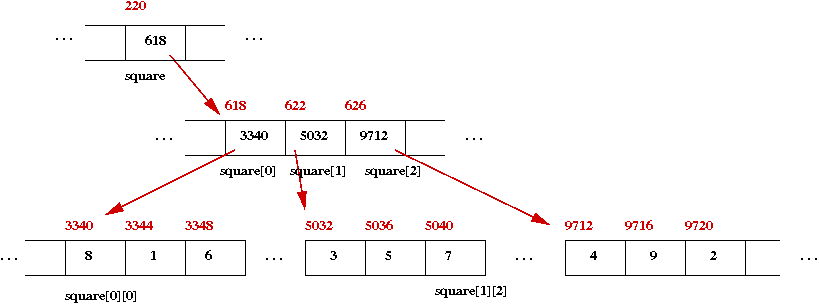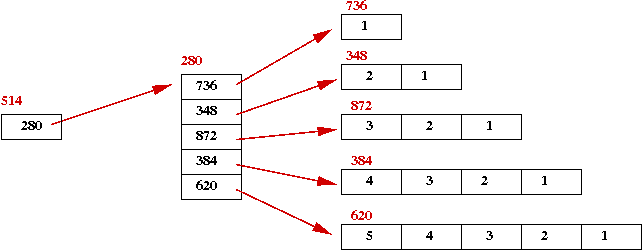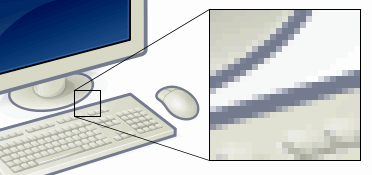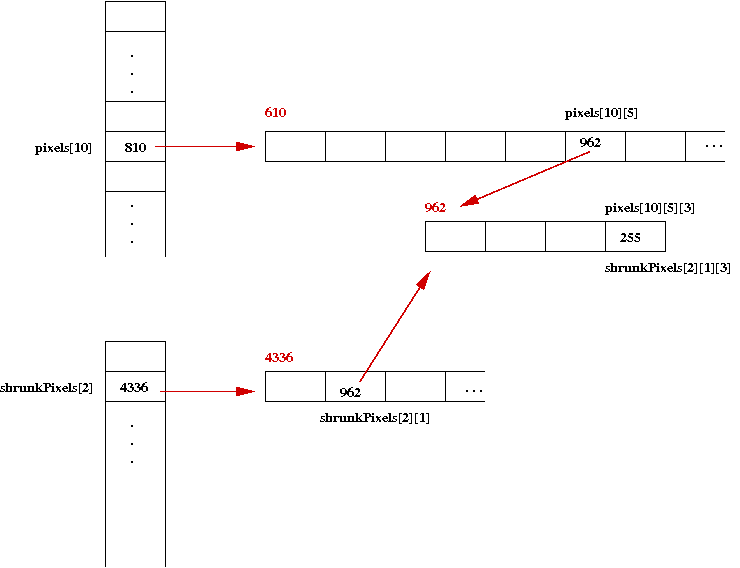About magic squares:
- Magic squares have fascinated mathematicians since antiquity
(earliest known example: 2200 B.C.)
- The number (e.g., 15 above) that is the sum along a row or
column is n (n2 + 1) / 2.
- There is no known algorithm for generating even squares.
For odd squares, there is a simple algorithm called the Staircase
Algorithm:
(source file)
public class MagicSquare {
public static void main (String[] argv)
{
// Some test cases.
int[][] square = generateSquare (3);
print (square);
square = generateSquare (5);
print (square);
}
// Current row/column and next row/column.
static int row, col;
static int nextRow, nextCol;
static int[][] generateSquare (int size)
{
// This algorithm only works for odd-sizes.
if (size % 2 != 1) {
System.out.println ("size must be odd");
System.exit (0);
}
int[][] A = new int [size][size];
// Start with middle in top row.
row = 0;
col = size/2;
A[row][col] = 1;
for (int n=2; n<=size*size; n++) {
// Go up diagonally to the right.
computeNext (size);
if (A[nextRow][nextCol] == 0) {
// Place next number here if unoccupied.
A[nextRow][nextCol] = n;
}
else {
// Else, place directly below current number.
nextRow = row + 1;
nextCol = col;
A[nextRow][nextCol] = n;
}
// Update.
row = nextRow;
col = nextCol;
} //end-for
return A;
}
static void computeNext (int size)
{
if (row == 0) {
// If we're at the top, next row wraps around.
nextRow = size - 1;
}
else {
// Otherwise, go to previous row.
nextRow = row - 1;
}
if (col == size-1) {
// If we're at the rightmost col, wrap around to leftmost.
nextCol = 0;
}
else {
// Otherwise, next column is the one to the right.
nextCol = col + 1;
}
}
static void print (int[][] A)
{
System.out.println ("Square: ");
for (int i=0; i < A.length; i++) {
for (int j=0; j < A[i].length; j++) {
System.out.printf ("%3d", A[i][j]);
}
}
}
}
Note:
- The program prints:
Square of size 3:
8 1 6
3 5 7
4 9 2
Square of size 5:
17 24 1 8 15
23 5 7 14 16
4 6 13 20 22
10 12 19 21 3
11 18 25 2 9
- Here's how it works:
- You start by placing "1" in the middle of the top row.
- Then, you try to place each successive number at the right
and above (Northwest direction) of the current number.
If that takes you out of the square, you wrap around.
- If the Northwest neighbor is occupied, then place the
next number in directly below the current one.
- You do not need to understand how it works to use it.
2D arrays in memory
Let's look at a simpler example
(source file)
public class MagicSquare2 {
public static void main (String[] argv)
{
// Some test cases.
int[][] square = {
{8, 1, 6},
{3, 5, 7},
{4, 9, 2}
};
print (square);
}
static void print (int[][] A)
{
// ... same as in MagicSquare.java ...
}
}
Note:
- A 2D array can be initialized to a "constant" just as
a unidimensional array can:
int[][] square = {
{8, 1, 6},
{3, 5, 7},
{4, 9, 2}
};
Here, the rows are enclosed in braces, and separated by commas.
- Java stores arrays using pointers:

- The variable square is a pointer: it points to
a sequence of "row pointers" at address "818" above.
- Each of the "row pointers" points to a unidimensional array.
- The three unidimensional arrays are the rows of the square.
Now let's consider a variation
(source file)
public class MagicSquare3 {
public static void main (String[] argv)
{
// Create space for the array, but not assign individual values:
int[][] square = new int [3][3];
assignValues (square);
print (square);
}
static void assignValues (int[][] A)
{
// ... the Staircase algorithm ...
}
static void print (int[][] A)
{
// ... same as before ...
}
}
Note:
- Thus, the new operator is used to create space:
int[][] square = new int [3][3];
- If we wished, we could separate variable declaration from space-creation:
int[][] square;
square = new int [3][3];
- An alternative to creating space:
// This is the main pointer.
int[][] square;
// This creates the (unidimensional) array of row-pointers.
square = new int [3][];
// For each row pointer, we create a row of three int's
for (int i=0; i < 3; i++) {
square[i] = new int [3];
}
Because arrays are implemented via pointers, we can create
irregular arrays.
(source file)
public class Triangle {
public static void main (String[] argv)
{
// Different-length rows.
int[][] A = {
{1},
{2, 1},
{3, 2, 1},
{4, 3, 2, 1},
{5, 4, 3, 2, 1}
};
print (A);
}
static void print (int[][] A)
{
// The number of rows is still A.length.
for (int i=0; i < A.length; i++) {
System.out.print ("Row i=" + i + " has " + A[i].length + " elements: ");
// Note: we must use A[i].length, since they are all different.
for (int j=0; j < A[i].length; j++) {
System.out.print (" " + A[i][j]);
}
System.out.println ();
}
}
}
Note:
- The number of rows is A.length.
- A[i] is the i-th row.
- Each row has a different length: row i has length
A[i].length.
- The "memory picture" for this array is something like this:

Images as 2D arrays
What is an image?
- An image is a 2D collection (array) of pixels:

- Each pixel itself
- can be a single number for a grey-scale image
=> the number = the intensity
- can be three numbers for a color image
=> each number = the intensity of that color
- Color images commonly use the intensity of the colors: Red,
Green, Blue (called RGB).
- Images sometimes have a 4-th number called
transparency, also called the alpha number.
- If the screen is painted with pixels according to the
given intensities, the eye is fooled into seeing a continuous image
provided the resolution is fine enough.
Image file formats:
- While images in main memory are stored as 2D arrays of pixels,
a file need not store all pixels.
=> instead, images are compressed (to take up less space)
- There are three popular file formats:
- GIF: a lossless compression format, but with some legal
problems.
- PNG: a lossless version of GIF without the legal problems.
- JPEG: a lossy format (much better compression).
Images in Java:
- Java uses the Image class to hold image data.
- Java supports the reading/writing of images in all three
formats: GIF, JPG and PNG.
- The format is recognized from the file type (usually
.gif, .jpg or .png).
- To manipulate pixels, we need the array of pixels.
- For some reason, Java has made it cumbersome to get the
pixels. Instead, you can use our own
ImageTool.java, which
simplifies pixel-access.
Useful methods in ImageTool:
- The very first thing to do is to make an instance of the tool:
ImageTool imTool = new ImageTool ();
- Use readImageFile() to read an image from a file:
Image image = imTool.readImageFile ("mymugshot.jpg");
- Use imageToPixels() to extract the pixels:
int[][][] pixels = im.imageToPixels (image);
- Use pixelsToImage() to convert pixels to an Image:
Image image2 = imTool.pixelsToImage (pixels);
- Use writeToJPGFile() to create a JPG file:
imTool.writeToJPGFile (image, "doctoredMugshot.jpg");
- Finally, use showImage() to view an image:
imTool.showImage (image);
Notice that the pixels are a 3D array:
int[][][] pixels = imTool.imageToPixels (image);
- Here, pixels[i][j] is the pixel in the i-th row
and j-th column.
- Each pixel is represented by four integers:
- pixels[i][j][0] is the
alpha value (the transparency, which for the most part we won't use).
- pixels[i][j][1] is the red intensity.
- pixels[i][j][2] is the green intensity.
- pixels[i][j][3] is the blue intensity.
- Each pixel intensity is an integer between 0 and 255 (inclusive).
- For example, here's how we can create a pure-white image with
500 x 500 pixels:
int size = 500;
pixels = new int [size][size][4];
for (int i=0; i < pixels.length; i++) {
for (int j=0; j < pixels[0].length; j++) {
for (int k=0; k < 4; k++) {
pixels[i][j][k] = 255;
}
}
}
- Let's draw a black box inside this image:
int start = size/4;
int end = (int) (3.0*size/4.0);
for (int i=start; i <= end; i++) {
for (int j=start; j <= end; j++) {
for (int k=1; k < 4; k++) {
pixels[i][j][k] = 0;
}
}
}
- To view the image:
ImageTool imTool = new ImageTool ();
Image image = imTool.pixelsToImage (pixels);
imTool.showImage (image);
Image transformations
Now let's manipulate some image pixels, starting with a "Thumbnail"
application:


